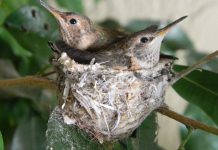A brand new scientific paper revealed within the journal Marine Ornithology paperwork the facility of neighborhood science throughout the west coast, and gives important info on a inhabitants of Brown Pelicans, a species of conservation concern.
Between 2016 and 2019 volunteers in California, Oregon, and Washington did someday counts of Brown Pelicans within the spring and fall, gathering knowledge on the species’ populations throughout the vary. The research, a part of a coordinated effort by Audubon California and the Bird Alliance of Oregon, discovered that the information collected gives significant perception into the species’ motion patterns, productiveness, and distribution.
“This is a wonderful example of how partnerships and community science monitoring programs can help us better understand species demographics, recovery, and responses to climate change,” said Daniel Orr, co-author and Director of Geospatial Science at Audubon California. “As we continue to see the negative impacts of climate change on bird species like the Brown Pelican, this kind of cost-efficient and widespread effort can be crucial to informing management and conservation of birds and their habitats across their ranges.”
Trained volunteers from Audubon chapters all alongside the coast participated within the four-year research, fanning out at round 60 areas in California, from Crescent City within the north to the Tijuana River to the south. The research documented a better proportion of younger pelicans throughout the west coast when nesting success of their southern California breeding grounds improved. This discovering highlights that neighborhood science surveys can present a transparent sign of pelican response to adjustments in breeding success. The enhance in productiveness was additionally correlated with an increase within the abundance of their major prey – anchovies – a forage fish important to the success of many seabird species.
“This study has provided insights into changes in the Brown Pelican’s distribution and coastal habitat use, which could not have been done without the coordinated effort of many volunteers across a large region,” stated Deborah Jaques, lead writer of the paper, and pelican knowledgeable. “The information from this effort could help in future management decisions to monitor and further protect the west coast pelican population.”
Another key discovering of the research confirmed that in comparison with historic information, Brown Pelican distribution in the course of the fall was shifting northward, with greater concentrations of birds in Oregon and Washington, in step with local weather change predictions.
Joe Liebezeit, paper co-author and Statewide Conservation Director for Bird Alliance of Oregon, stated, “Over 100 community scientists along the west coast surveyed pelicans at over 80 sites per year. It’s impressive that a concerted effort by a large group of volunteers can shed new light on this iconic yet vulnerable seabird. We thank the many volunteers who contributed to this study for the welfare of this amazing bird.”
Brown Pelicans are an iconic and beloved seabird on the west coast. These seabirds are immediately recognizable by their giant physique, lengthy invoice, monumental throat pouch, and their spectacular head-first diving for small forage fish prey. While Brown Pelicans had been faraway from the endangered species listing in 2009 after a considerable restoration following the DDT ban in 1972, the species remains to be susceptible to environmental stressors. In current years they’ve suffered some uncommon waves of hunger and catastrophic nest failures of their breeding grounds in southern California and Mexico. This research factors to the potential of neighborhood science snapshot surveys as a crucial, cheap, and inclusive device to higher perceive and shield this essential species.
###
Media contact: Shineh Rhee, Communications Director, Audubon California
shineh.rhee@audubon.org
415.644.4605
Audubon California is a regional workplace of the National Audubon Society. Learn extra at audubon.org/california and observe us on Instagram, Facebook, and Twitter @AudubonCA.
The National Audubon Society is a number one nonprofit conservation group with 120 years of science-based, community-driven influence, devoted to defending birds and the locations they want, right this moment and tomorrow. Birds are highly effective indicators of our planet’s well being, appearing as sentinels that warn us of environmental change and encourage motion. Audubon works throughout the Western Hemisphere, pushed by the understanding that what is sweet for birds is sweet for the planet. Through a collaborative, bipartisan method throughout habitats, borders, and the political spectrum, Audubon drives significant and lasting conservation outcomes. With 800 employees and over 1.9 million supporters, Audubon is a dynamic and ever-growing pressure dedicated to making sure a greater planet for each birds and other people for generations to return.









































